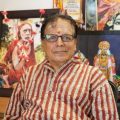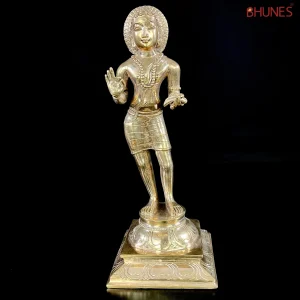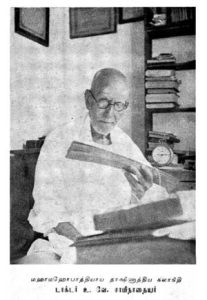

SADHGURU SWAMI GNANANANDA OF TAPOVANAMJ K SIVAN
Many of us know the name SWAMI GNANANANDA of Tapovanam, but those who have had His dharshan are quite fortunate. He was a great saint who lived amidst us until recently. I write this for the information of those who have not heard about Him or not fortunate to have His dharshan. For those who know about Him and have read about Him, let this refresh their memory.
Sri Gnanananda was a Himalayan sage, a great yogi and a legend in his own lifetime. He conquered the aging process of body keeping everyone guessing about his age. I have heard many devotees say that he lived for about 350 years. He would parry all questions about it, as many were curious to know the secret of His longevity. He used to direct them to inquire about the Immortal Spirit, Athma within, and not worry about the mortal perishable body. He would not speak about the past, His sadhana, His miracles and other spiritual attainments, which were obviously extraordinary and known to those who were His close devotees. Swamiji always considered that all achievements belong to the realm of the ego. He never used to guide the disciples but requested them to self search for knowledge of Atma.
He lived from moment to moment, in the Eternal Now, with no thoughts of a dead yesterday and unborn tomorrow.
Swami Gnanananda’s early life is an unknowable mystery. It is believed that He was born nearly two hundred years ago. It is reported that He was born in a Karnataka village near Mangalore, on the west coast of South India. Even as a boy, by the grace of the Almighty, He walked to Pandharpur, a great center of Maharashtra mysticism. There He met His guru, the pontiff of the northern regional center of advaita at Badrinath, established by Sri Adhi Sankaracharya. Swami Gnanananda accompanied His guru to Srinagar in Kashmir and after the latter’s mahasamadhi He spent many years performing austerities in the higher altitudes of the Himalayas, visited Kailash,, Nepal, Burma, and Sri Lanka before settling in Tamil Nadu. Sometime around 1860 Swamiji visited Chidambaram. Swamiji walked everywhere for over many decades as a parivrajaka, dedicated monk, coming into contact with the spiritual luminaries of His time. At the beginning of 20th century Swamiji stayed in the Sampathgiri Hills of Polur near Tiruvannamalai.
Swamiji was with Sri Aurobindo, who arrived Pondicherry from Chandarnagore. Sri Gnanananda also met with Sri Ramana Maharshi in the Virupaksha Cave. He was first and foremost a paramahamsa parivrajaka, a true wandering monk without belongings or obligations. He remained a simple sadhu roaming alone, in anonymity, as a true sanyasi till His end.
He moved away as disciples built ashrams for Him. After a long time He settled down at Thapovanam on the outskirts of the ancient temple town of Tirukovilur on the banks of a sacred river Pennar, within the spiritual aura of Arunachala. The ashram is situated about 1 km away from the 400 year-old samadhi tomb of another great Hindu saint, Sri Raghottama Swami. It is located on the Tiruvannamalai-Tirukovilur highway, about 200 km from Chennai. I have been fortunate to visit His ashram and meditate for about an hour.
The earliest inmates of the ashram, were monks mainly from Sri Shivananda Ashram of Rishikesh in the Himalayas. Later, the locals, mostly house holders stayed in the ashram and served the saint. Brahmacharis came for spiritual guidance and served the guru and learnt vedic scripts under monks who trained them. Many came for initiation into monastic life. Sri Gnanananda was deeply interested in monastic revival and gave initiation into traditional sannyasa to many.
In 1969 Sadguru Gnanananda established a retreat center at Yercaud, a hill station, called Sri Gnanananda Pranava Nilayam for meditation on Atman and “OM”, the pranava. There is no ritual or communal worship at Yercaud. Sri Gnanananda propagated the importance of Karma Yoga and Bhakti Yoga. Devotees in large number were trained in His ashram for worship of deities. Thus Thapovanam sannyasins are trained in study and practicing meditation side by side with bhaktas, devotees singing kirtans in the praise of the Lord. Some of them prefer ritualistic worship with Vedic chants. Thus the unique institution represents the many facets of the Master’s personality.
Fr. Henri Le Saux, a Benedictine monk from the monastery of Kergonan in France met Swamiji at Thapovanam in December 1955 and became Swami Abhishiktananda. He together with Fr. Jules Monchanin, founded a Christian ashram at Shantivanam, Kulitalai, near Trichy in Tamil Nadu. He was already acquainted with the teachings of Bhagawan Sri Ramana Maharshi, the Sage of Arunachala and of the Upanishads, and was attracted to the caves of Arunachala at Tiruvannamalai. Sri Gnanananda also made a very deep impression on him. As advised by him, he came again to Thapovanam in February 1956 for two weeks of retreat in silence and meditation. He enabled the disciples to know Vedanta, the upanishads, and taught them mahavakyas explaining them in detail for easy understanding.
Sri Gnanananda was not for all cheap spirituality. His teaching is fundamentally the way of total renunciation so that finally there is no ego left to manifest itself. His teachings are the same as that of the Upanishads.. Being is Knowing. Gnanananda’s whole being radiated a pure and tender love, a love which was complete for each and everyone. Devotees visiting Tapovanam received Swamiji’s abundant love. It exclusively filled everyone’s heart and resulted in a high degree of detachment. It was the personality of the Self alone, the Atman, in each person which was immediately perceived by Him with no discrimination of caste, gender or creed. Sri Gnanananda was a Rishi living out of the pages of the Upanishads.
A Jesuit priest from Tamil Nadu, drawn to advaita, met Sri Gnanananda. He asked the sage whether he should become a Hindu to pursue his advaitic Vedantic sadhana. Swamiji told him that there was no need to change one’s religion. Vedanta is the transcendent element in all great religions. Everyone should go deep into his own religion and would discover it there.
Sri Gnanananda preached that one should evolve athma vicharam to realize God as his own Self, which is the transcendent element in all religions. Like the nucleus of the atom, the innermost core of any religion explodes when the abyss of man’s consciousness is pierced to its depth by the ray of Pure Awakening.




